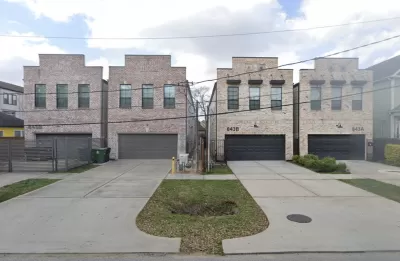A proposed rule would require developers to build shared driveways for narrow lot projects.

Houston officials are debating a proposed change to the city’s development code that would require narrow lot developments with two units to build a shared driveway rather than two separate ones, reports Dug Begley in the Houston Chronicle. “Rather than building two driveways up to 16 feet wide on a single property, the proposed change to Chapter 42 of the city’s code of ordinances would allow a single 18-foot-wide Y-shaped driveway that would give each home a place to park but a shared entrance and exit.”
For planners, this would return public property to the public and keep more of the street unbroken to protect pedestrians and cyclists and create more curbside parking or space for other amenities. Developers claim the driveway requirement could increase the number of cars parked on city streets and “limit what developers can build because of the increasing price of land in many areas.”
Begley explains, “Along some blocks in Houston’s historic areas, including Rice Military, the Heights and some places around Loop 610, the rapid construction of townhomes and other dense development has led to a near-continuous line of breaks in street curbs for driveways.” As one resident put it, “Why not just take away the sidewalk entirely if there is nothing but driveways?”
The driveway question is one part of a broader set of changes developed by “a committee of city staff and homebuilders created in 2020 to discuss modifications to the city’s development rules aimed at making Houston’s public space safer and more accessible as part of its Livable Places initiative.” Other proposals include permitting courtyard housing, encouraging alley-facing garages, and loosening regulations on accessory dwelling units (ADUs).
FULL STORY: City planners, developers differ over driveways as part of homebuilding rules overhaul

Planetizen Federal Action Tracker
A weekly monitor of how Trump’s orders and actions are impacting planners and planning in America.

San Francisco's School District Spent $105M To Build Affordable Housing for Teachers — And That's Just the Beginning
SFUSD joins a growing list of school districts using their land holdings to address housing affordability challenges faced by their own employees.

The Tiny, Adorable $7,000 Car Turning Japan Onto EVs
The single seat Mibot charges from a regular plug as quickly as an iPad, and is about half the price of an average EV.

Seattle's Plan for Adopting Driverless Cars
Equity, safety, accessibility and affordability are front of mind as the city prepares for robotaxis and other autonomous vehicles.

As Trump Phases Out FEMA, Is It Time to Flee the Floodplains?
With less federal funding available for disaster relief efforts, the need to relocate at-risk communities is more urgent than ever.

With Protected Lanes, 460% More People Commute by Bike
For those needing more ammo, more data proving what we already knew is here.
Urban Design for Planners 1: Software Tools
This six-course series explores essential urban design concepts using open source software and equips planners with the tools they need to participate fully in the urban design process.
Planning for Universal Design
Learn the tools for implementing Universal Design in planning regulations.
Smith Gee Studio
City of Charlotte
City of Camden Redevelopment Agency
City of Astoria
Transportation Research & Education Center (TREC) at Portland State University
US High Speed Rail Association
City of Camden Redevelopment Agency
Municipality of Princeton (NJ)




























